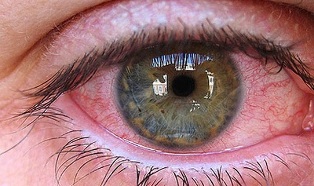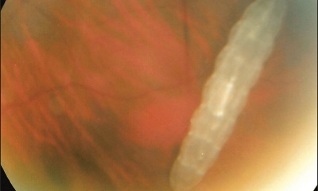
Eye parasites are round and flattened, less often grooved and dottedworms, fly larvae and mosquitoes. After entering the human body, they gradually spread through it, damaging tissues and organs. Most of them have the ability to parasitize in the human eye, provoking the development of helminthiasis in the eye.
Clinically, these severe conditions are manifested by pain, burning, itching, visual disturbances, watery eyes. Surgical and / or conservative treatment is performed as soon as a diagnosis is made.
Diseases caused by parasites of the eye
More than 50 pathogens of ocular helminths are known. Some penetrate directly through the mucous membrane, damaging the conjunctiva or tear duct. Others get an infection of the eyeball from the inside, which travels into it with blood flowing from the intestine or liver. The parasites begin to actively develop and multiply, laying eggs, resulting in partial or complete vision loss.
The most commonly diagnosed helminthiasis is:- onchocerciasis- helminthiasis caused by parasitic parasites in human body of the nematode Onchocerca (onchocercias). Its specific symptom is corneal "cloudiness" of the eye;
- mycosisis a parasitic disease of the eye and its appendages that occurs when larvae of flies or butterflies invade. In severe cases, pupil dilated, retinal detachment or optic nerve atrophy;
- dirofilariasis- helminthiasis develops when the nematode larvae enter the eyeball. The movements of the worms cause a burning sensation, intense pain, and itching;
- sparganosisis a human disease of the cestodosis group caused by the larvae of a tapeworm of the genus Spirometra. Infection occurs mainly through consumption of wild animal meat;
- Toxocara canis diseaseis a chronic infectious disease caused by the larvae of toxocara roundworm. The source of infection is sick animals (usually dogs);
- toxoplasmosisis a chronic invasive parasitic disease caused by intracellular protozoa (toxoplasma). Their vital activity is accompanied by the constant release of allergens and toxins;
- coenurosisis a chronic disease that mainly occurs after helminth infection from the helminth group of the Taenia multiceps species. A person becomes infected by contact with a dog;
- tapeworm- a disease caused by the swine tapeworm larvae that can lead to vision loss and blindness;
- gnatostomosis- a disease that causes severe pain and often leads to death. The worms that cause this disease usually affect the skin, less often the central nervous system and eyes;
- echinococcosis of the eyeis a fairly common disease. It is characterized by the formation of parasitic cysts in the orbital region. Echinococcosis develops from ingestion of parasitic eggs with food or drinking water.
- eyelid trichiasis, is caused by the activation of ticks that live in the sebaceous glands of the eyelashes.
- Trichinosisis a parasitic disease that develops after the introduction of Trichinella helminths into the human body.

It is not sexually mature individuals and larvae that are an eye hazard but are the toxins they release. They are the cause of puffiness and redness of the mucous membranes.
Ocular parasitic symptoms
Each infestation of a helminth has its own specific symptoms. But they also have many common signs like damage to the mucous membranes and deeper structures of the eyes.
At the early stages of the development of the pathology, typical manifestations of conjunctivitis occur:
- red outer crust of the eyeball;
- increased tearing;
- is afraid of light;
- swelling of the upper and lower eyelids;
- pain, itching, burning;
- focal headache in temples and posterior head;
- slightly increased local temperature.
Children and frail people develop symptoms of general intoxication of the body. Temperature increases above values below threshold (37, 1-38, 0 ° C), appetite decreases due to nausea and vomiting.
Unlike many infections caused by viruses, bacteria, and fungi, helminthiasis is accompanied by signs of damage to other organs. These include pain from muscle movement, dry skin, slow hair growth and indigestion.
How to remove parasites from the eyes
Diptera larvae, protozoa, ticks and other parasitic pathogens can quickly destroy the eye structure. So, treatment is carried out immediately after diagnosis. When choosing a treatment strategy, doctors must take into account the type of infectious agent, the severity of the disease course, and the severity of symptoms.
If an infected person visits a doctor with advanced helminth infestation, then conservative treatment is often not effective.
Parasitic worms must be removed surgically - by opening and draining the abscess socket according to generally accepted rules.
And then a long time of recovery with the use of helminth bleach.
Folk remedies
Even with long-term use strong modern worm bleaches are often ineffective in such ailments. Urgent surgery is required to remove the larvae, eggs and adult sex of individuals.
And traditional medicine is completely powerless when the eye is infected with worms. Neither the herbaceous plant, the honeysuckle, or the sagebrush can cope with invasive eye disease.
The use of decoctions and infusions alleviates symptoms, so the patient adjourned to see a doctor. Meanwhile, inflammatory and destructive processes intensified and spread in his eyeballs. They lead to retinal detachment, complete or partial blindness.
Medicines
Different treatment regimens for worm-induced ophthalmia have been developed. Individual therapy is performed only by specially trained parasites. The fact is that after the death of helminths and their disintegration, intraocular intoxication allergic reactions can develop. Only an experienced doctor can minimize their consequences.
The following drugs are used to kill parasitic worms:
- anti nematodes;
- anti-cestodial;
- parasite;
- broad spectrum drug.
For external agents, special eye wash solutions are used. Antihistamines should be included in the treatment regimen, and if necessary, antibiotics and antipyretics.
Precautions
A pupil infection occurs when the mucous membrane of the eye comes into contact with flies, mosquitoes, and flies. So doctors for infectious diseases recommend repellants in the form of sprays, gels, and ointments. Smoke bombs have insecticides that repel insects in nature quite well.
But the eggs and larvae of the parasitic worms are fed into the human body mainly with food. They are not stable to the effects of temperature - they die when heated and boiled. It is also important to wash vegetables and fruits from the market and store them well.
Eye diseases caused by parasites cannot be independently diagnosed and cured.
They are often disguised as infections caused by bacteria, viruses, or fungi. And only as they progress will their distinctive features emerge.
Seeing your doctor promptly will help protect your eyesight, avoid vision loss.





























